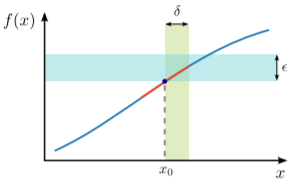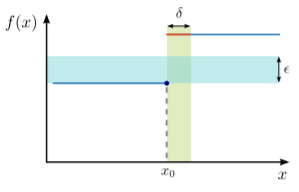1.7: Continuity
( \newcommand{\kernel}{\mathrm{null}\,}\)
Continuity
Continuity is an important concept in the theory of real functions. A continuous function is one whose output f(x) does not undergo abrupt jumps when x changes by tiny amounts. A function can be continuous over its entire domain, or only a subset of its domain. For example, sin(x) is continuous for all x, whereas f(x)=1/x is discontinuous at x=0. Another function that is discontinuous at x=0 is the step function Θ(x)={1,forx≥00,otherwise. Mathematicians have even come up with functions that are discontinuous everywhere in their domain, but we won’t be dealing with such cases.
The rigorous definition of continuity is as follows:
Definition: Word
A function f is continuous at a point x0 if, for any ϵ>0, we can find a δ>0 such that setting x closer to x0 than a distance of δ brings f(x) closer to f(x0) than the specified distance ϵ.
That’s a very complicated sentence, and it may be easier to understand using this illustration:

A counter-example, with a function that has a discontinuity at some x0, is shown below:

If we choose ϵ smaller than the gap, then no matter what value of δ>0 we try, any choice of 0<x<δ will give a value of f(x) that’s further than ϵ from f(x0). Hence, the continuity condition is violated for sufficiently small choices of ϵ=1/2, and we say that f is discontinuous at x0.


